Research on Key Parameters for Relieving Pressure on Roofs of Deep Mine Cutting and Retaining Roadways
Abstract
:1. Introduction
2. Quantitative Relationship of Roof-Cutting Parameters for the Retaining Roadway Roof
2.1. Project Overview
2.2. Quantitative Relationship Analysis of Roof Cutting Parameters for Retaining Roadway
3. Analysis of Pressure Relief Effect of Cutting Top Parameters
3.1. Model Establishment
3.2. Pressure Relief Effect of Different Top Cutting Parameters
3.2.1. Pressure Relief Effect of Roof-Cutting Height
3.2.2. Pressure Relief Effect of Roof-Cutting Angle
4. Verification of Pressure Relief Effect of Roof Cutting and Roadway Retention
5. Conclusions
Author Contributions
Funding
Institutional Review Board Statement
Informed Consent Statement
Data Availability Statement
Acknowledgments
Conflicts of Interest
References
- He, M. Theory and engineering practice for non-pillars mining with auto magical entry formation and 110 mining method. J. Min. Saf. Eng. 2023, 40, 869–881. [Google Scholar]
- Xu, X.; He, F.; Lú, K.; Wa, D.; Li, L.; Zhai, W. Research on reasonable cutting roof parameters of gob side entry retaining by roof cutting in thick and hard roof. J. China Coal Soc. 2023, 48, 3048–3059. [Google Scholar]
- He, M.; Guo, P.; Zhang, X.; Wang, J. Directional pre splitting of roadway roof based on the theory of bilateral cumulative tensile explosion. Explos. Shock Waves 2018, 38, 795–803. [Google Scholar]
- Zhai, W.; He, F.; Wang, Z.; Liu, D.; Song, J.; Wu, Y.; Xu, X. Research on the effect of roof cutting and surrounding rock control in narrow coal pillars along goaf coal roadway in fully mechanized top coal caving of ultra-thick coal seams. J. Min. Saf. Eng. 2024. Available online: https://link.cnki.net/urlid/32.1760.td.20240304.1427.002 (accessed on 2 June 2024).
- Kang, H.; Zhang, X.; Wang, D.; Ti, J.; Yi, Z.; Ji, W. Strata control technology and applications of non-pillar coal mining. J. China Coal Soc. 2022, 47, 16–44. [Google Scholar]
- Hua, X.; Li, C.; Liu, X.; Guo, Y.; Qi, Y.; Chen, D. Current situation of gob-side entry retaining and suggestions for its improvement in China. Coal Sci. Technol. 2023, 51, 128–145. [Google Scholar]
- Gao, Y.; Yang, J.; Wang, Q.; Wang, Y.; He, M. Mechanism of roof presplitting in a non-pillar mining method with entry automatically retained and its influence on the strata behaviors. J. China Coal Soc. 2019, 44, 3349–3359. [Google Scholar]
- Yuan, C.; Yuan, Y.; Zhu, C.; Meng, C. Reasonable parameters of roof cutting entry retaining in thin immediate roof and large mining height fully-mechanized face. J. China Coal Soc. 2019, 44, 1981–1990. [Google Scholar]
- Zhang, B.; Wang, P.; Cui, S.; Fan, M.; Qiu, Y. Mechanism and surrounding rock control of roadway driving along gob in shallow-buried, large mining height and small coal pillars by roof cutting. J. China Coal Soc. 2021, 46, 2254–2267. [Google Scholar]
- Hou, G.; Hu, T.; Li, Z.; Chen, J.; Cui, Y. Effect of cutting roof height on the stability of gob-side retaining roadway with roadside support. J. Min. Saf. Eng. 2019, 36, 924–931. [Google Scholar]
- Wei, Q.; Wang, Y.; Yang, J.; Gao, Y.; Hou, S.; Qiao, B. Roof deformation mechanism and control measures of pillarless mining with gob-side entry retaining by roof cutting and pressure relief. Rock Soil Mech. 2020, 41, 989–998. [Google Scholar]
- Hu, C.; Wang, J.; He, M.; Wang, X.; Wang, J.; Zhang, Z. Study on key parameters of self-formed roadway without coal pillar by roof cutting and pressure relief in medium and thick coal seam. Coal Sci. Technol. 2022, 50, 117–123. [Google Scholar]
- Yang, H.; Li, Y.; Liu, Y.; Cao, S.; Pan, R.; Wang, H.; Wang, B.; Chen, X.; Zhao, X. Structure evolution and stability control mechanism of hard-roof cutting for roadway retaining. J. Min. Saf. Eng. 2021, 38, 766–773. [Google Scholar]
- Zhao, M.; Huang, Q.; Zhu, L.; Huang, K.; Qiu, F.; Xi, X. Research on roof structure and support resistance of gob-side entry retaining with roof cutting and non-pillar mining. J. China Coal Soc. 2021, 46, 84–93. [Google Scholar]
- Chang, J.; Qi, C.; Xiong, T. Study on pressure relief control technology of surrounding rock around the staggered roof roadway in a deep long wall face. J. Min. Saf. Eng. 2023, 40, 215–223. [Google Scholar]
- He, M.; Wu, Y.; Gao, Y.; Tao, Z. Research progress of rock mechanics in deep mining. J. China Coal Soc. 2024, 49, 75–99. [Google Scholar]
- Kang, H.; Jiang, P.; Yang, J.; Wang, Z.; Yang, J.; Liu, Q.; Wu, Y.; Li, W.; Gao, F.; Jang, Z.; et al. Roadway sold coal control technology by means of grouting bolts with high pressure –shotereting in synergy in more than 1000 m deep eoal mines. J. China Coal Soc. 2021, 46, 747–762. [Google Scholar]
- Cheng, L.; Kang, H.; Jang, P.; Li, W.; Yang, J.; Zheng, Y.; Yi, K. Deformation and failure characteristics and control technology of surrounding rocks in deeply gob-side entry driving. J. China Coal Soc. 2021, 38, 227–236. [Google Scholar]
- Su, C.; Gong, P.L.; Kang, H.P.; Li, C.; Yi, K.; Liu, C.; Li, P. Mechanism of roof cutting and pressure relief in gob-side and high-stress roadway in deep mine. J. China Coal Soc. 2020, 37, 1104–1113. [Google Scholar]
- Chen, S.; He, M.; Wang, H.; Yuan, G.; Zhao, F.; Guo, Z. Coordination control and stress evolution of surrounding rock of gob-side entry retaining cutting roof in deep mine. J. Min. Saf. Eng. 2019, 36, 660–669. [Google Scholar]
- Gao, Y.; Yang, J.; Zhang, X.; Xue, H.; He, M. Study on Surrounding Rock Control of Roadways in Deep Coal Mines Based on Roof Cutting and Pressure Release Technology by Directional Tensile Blasting. Chin. J. Rock Mech. Eng. 2019, 38, 2045–2056. [Google Scholar]
- Liu, X.; Hua, X.; Yang, P.; Yang, S.; Ma, Y. A quantitative study on roof dislocation criterion and support parameters of entry retaining by roof cutting in deep mine. J. Min. Saf. Eng. 2021, 38, 1122–1133. [Google Scholar]
- Hua, X.; Liu, X.; Huang, Z.; Yang, P.; Ma, Y. Stability mechanism of non-pillar gob-side entry retaining by roof cutting under the coupled static-dynamic loading. J. China Coal Soc. 2020, 45, 3696–3708. [Google Scholar]
- He, M.; Ma, Z.; Guo, Z.; Chen, S. Key parameters of the gob side entry retaining formed by roof cutting and pressure release in deep medium-thickness coal seams. J. China Univ. Min. Technol. 2018, 43, 468–477. [Google Scholar]

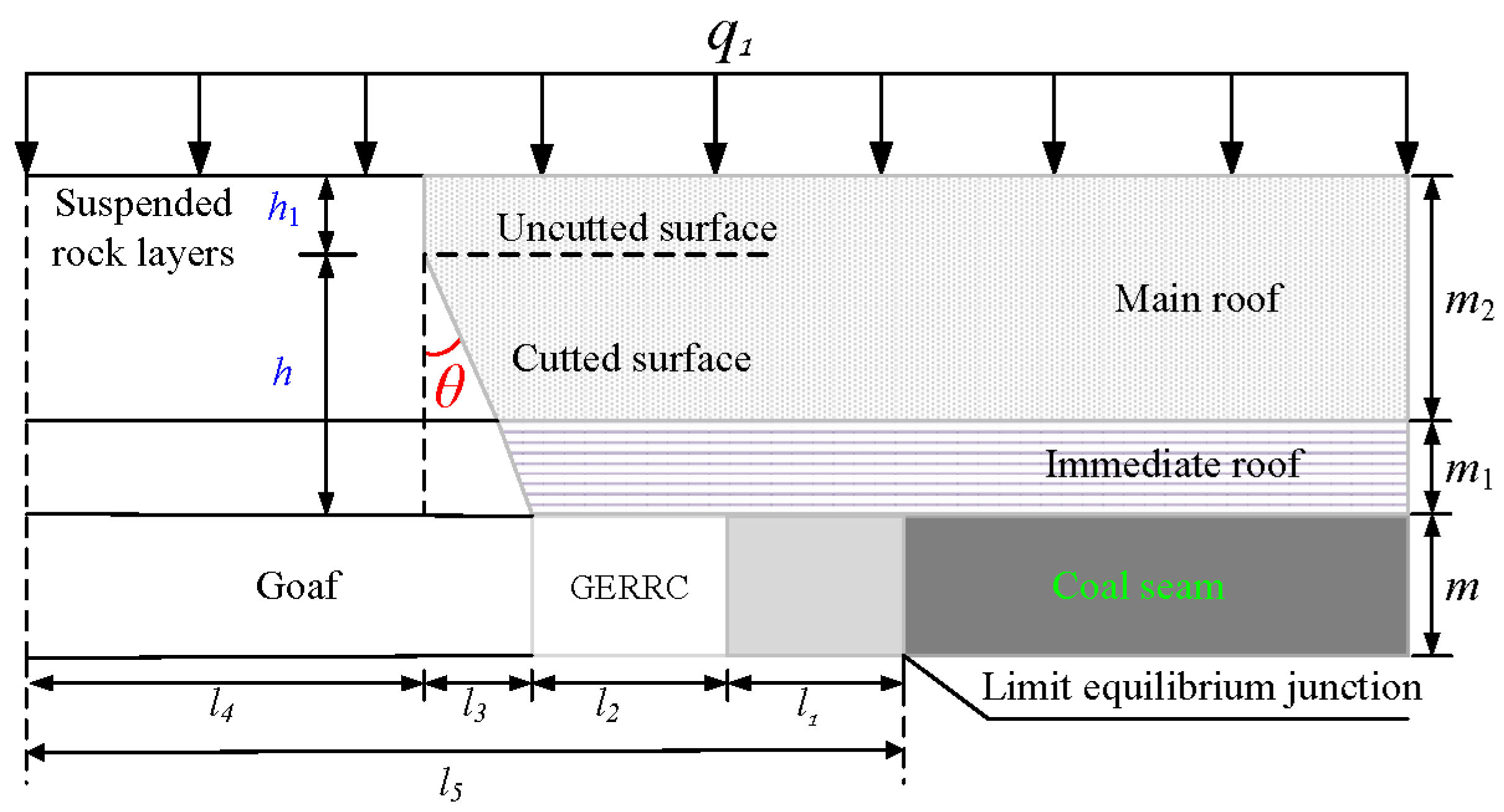
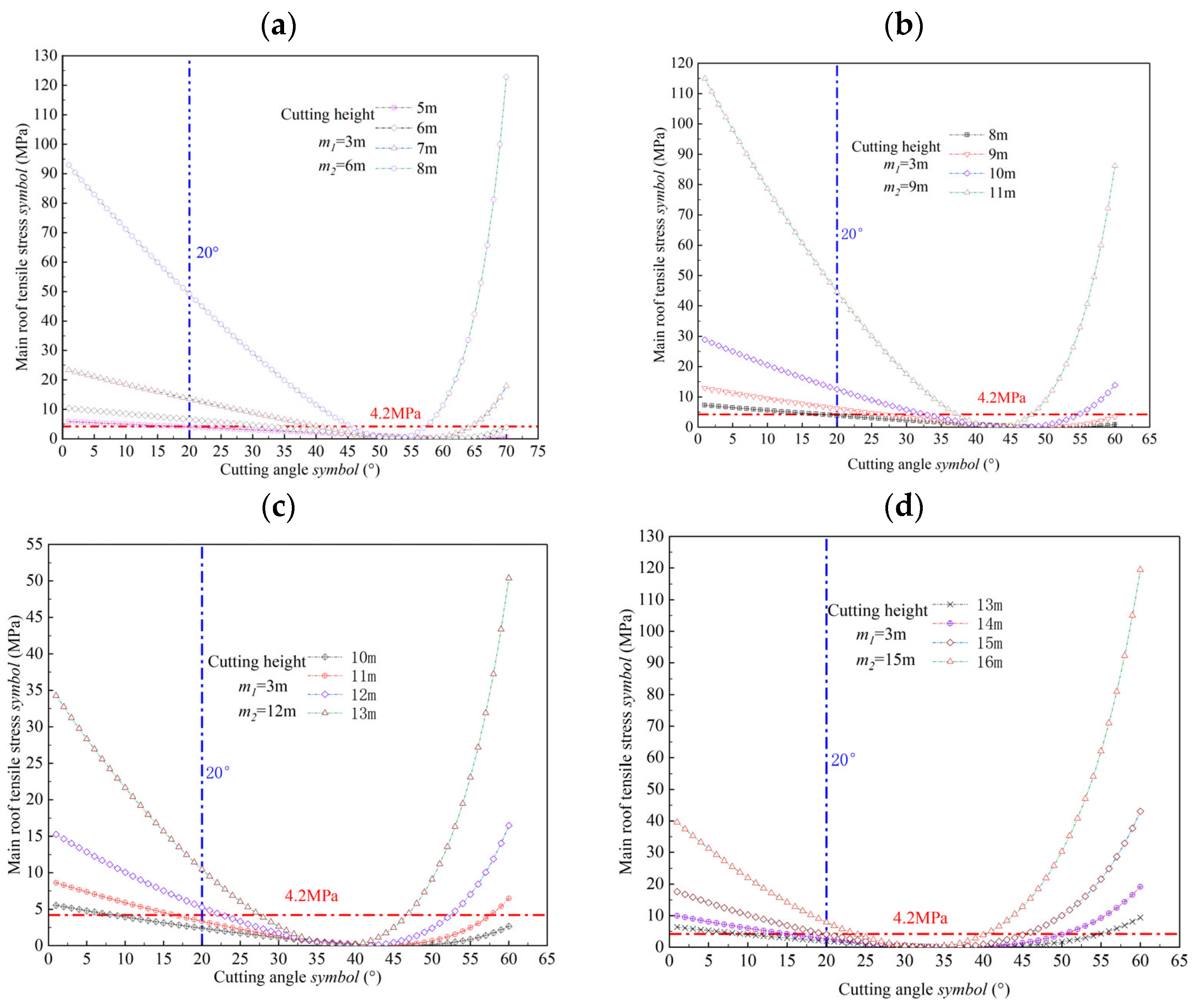
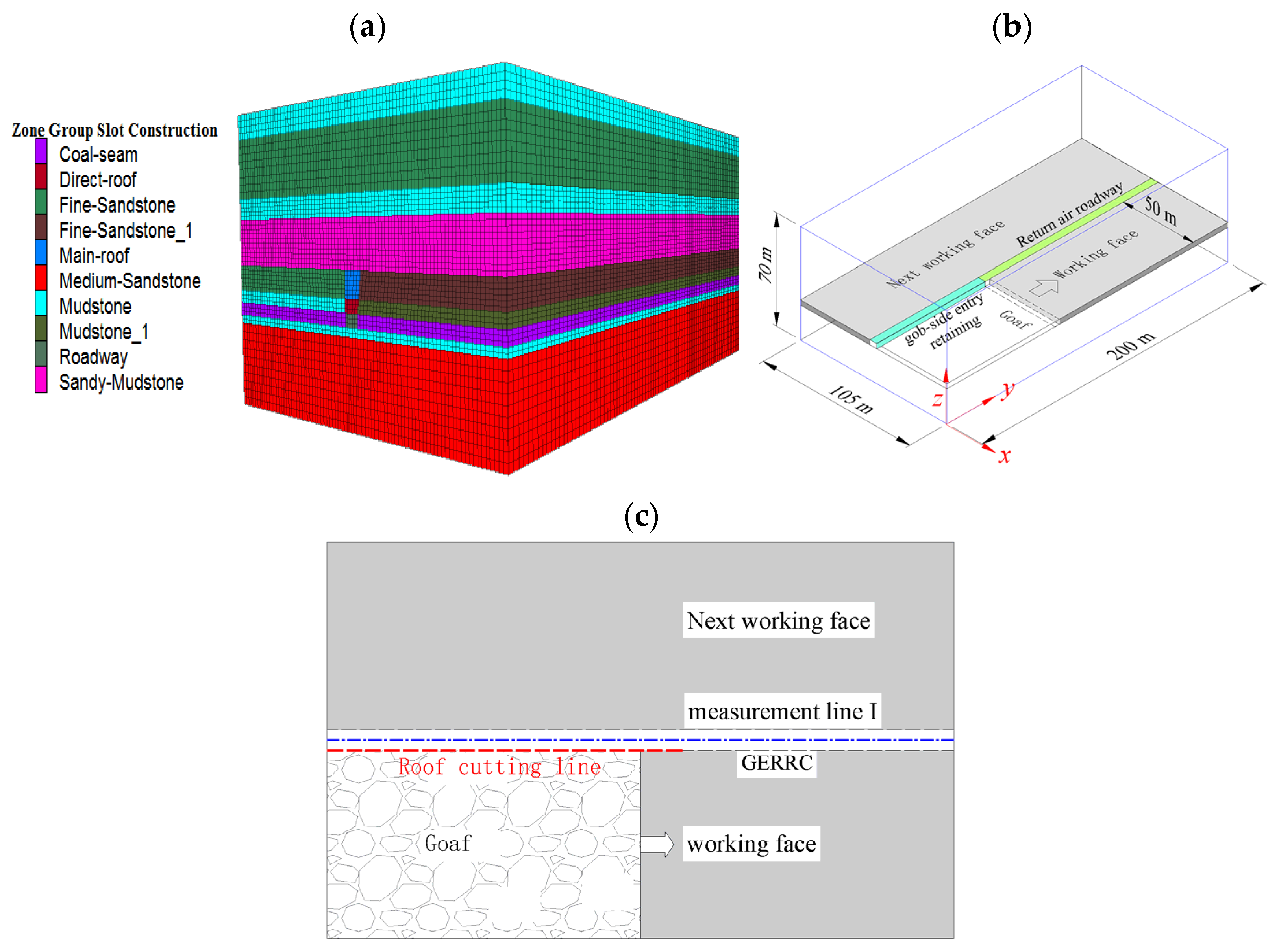
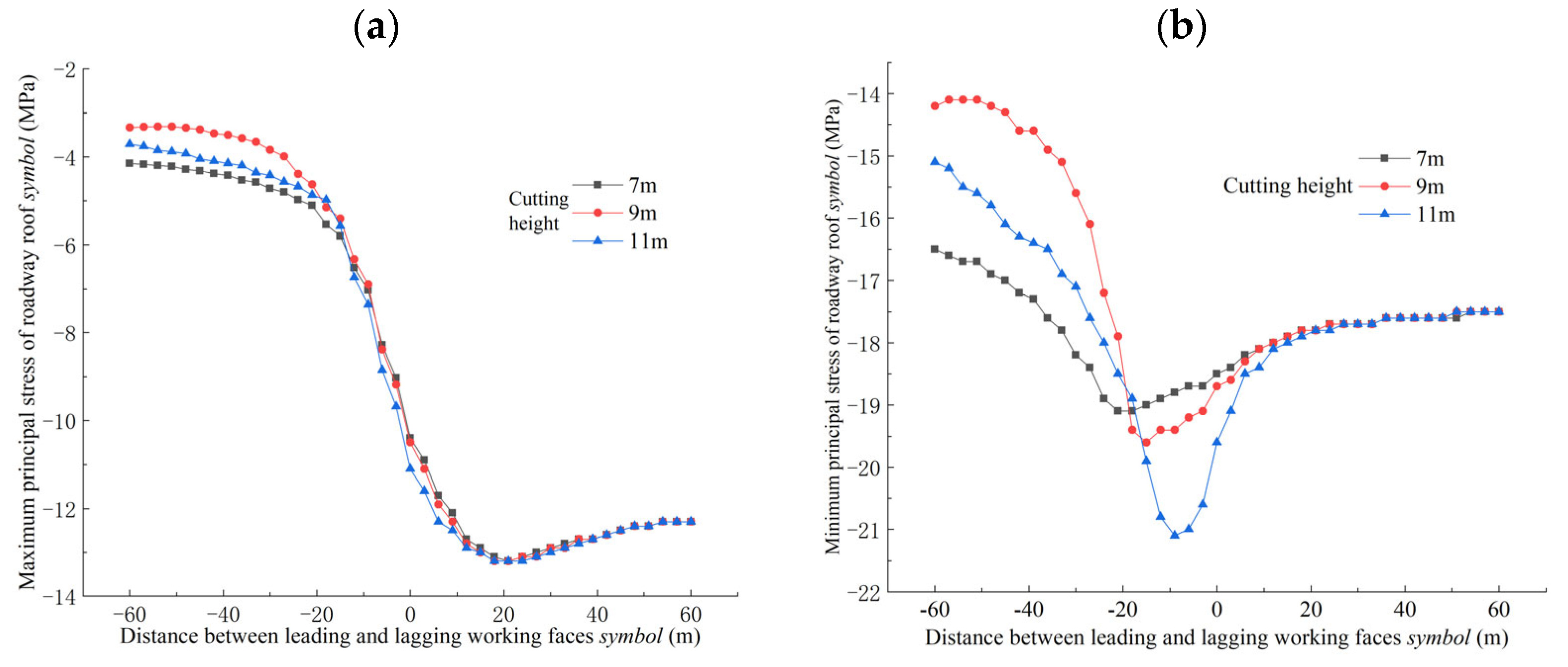


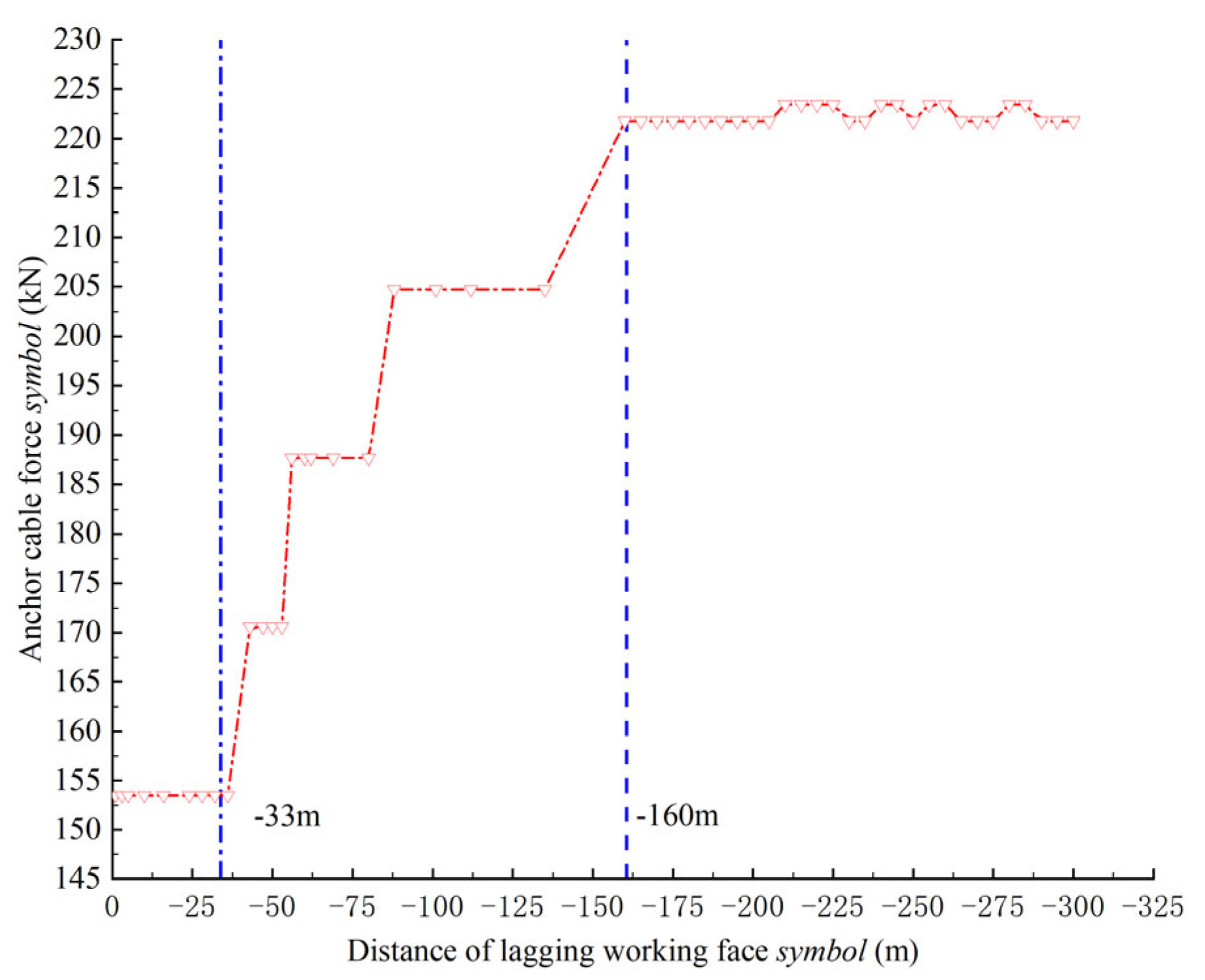
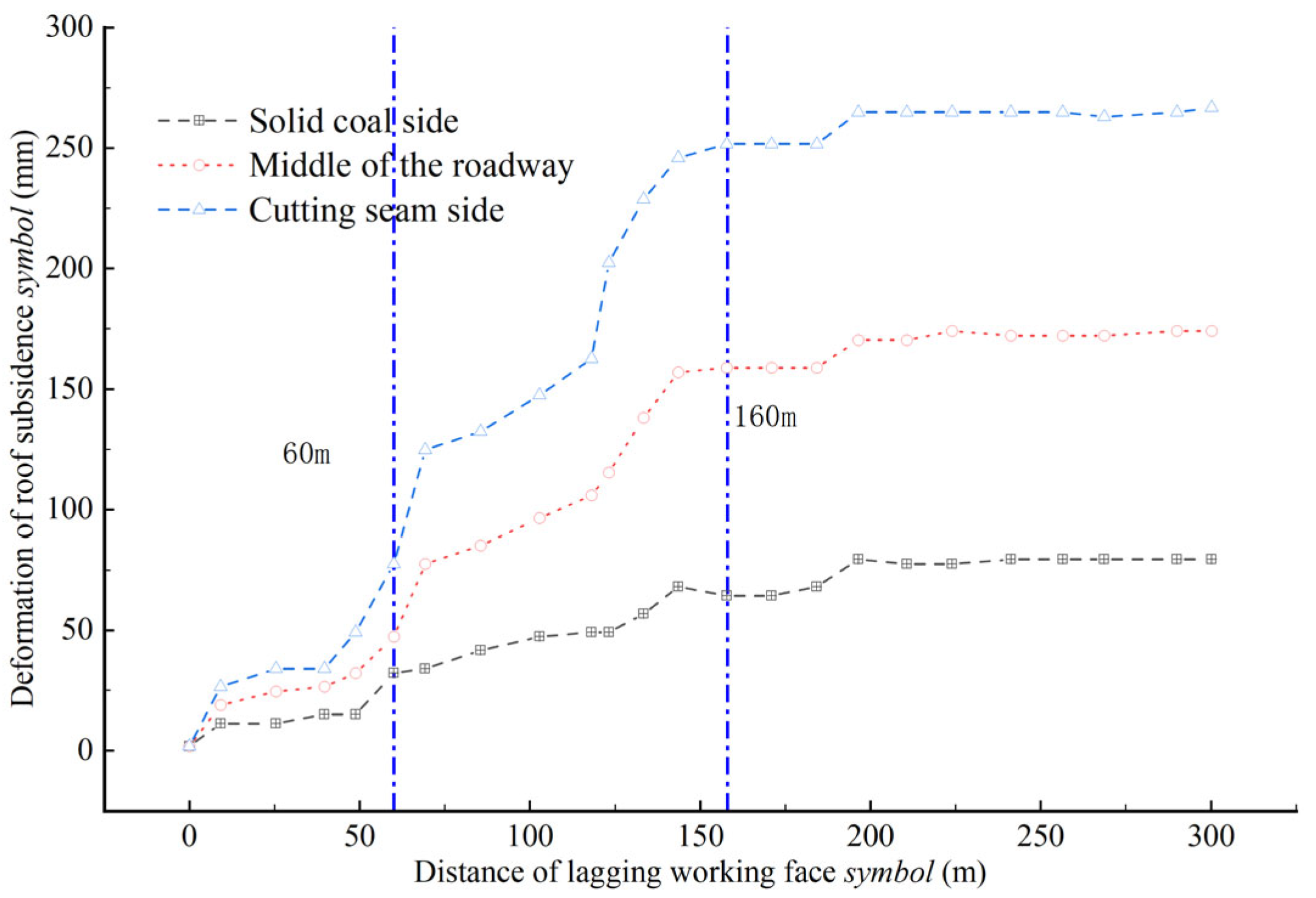
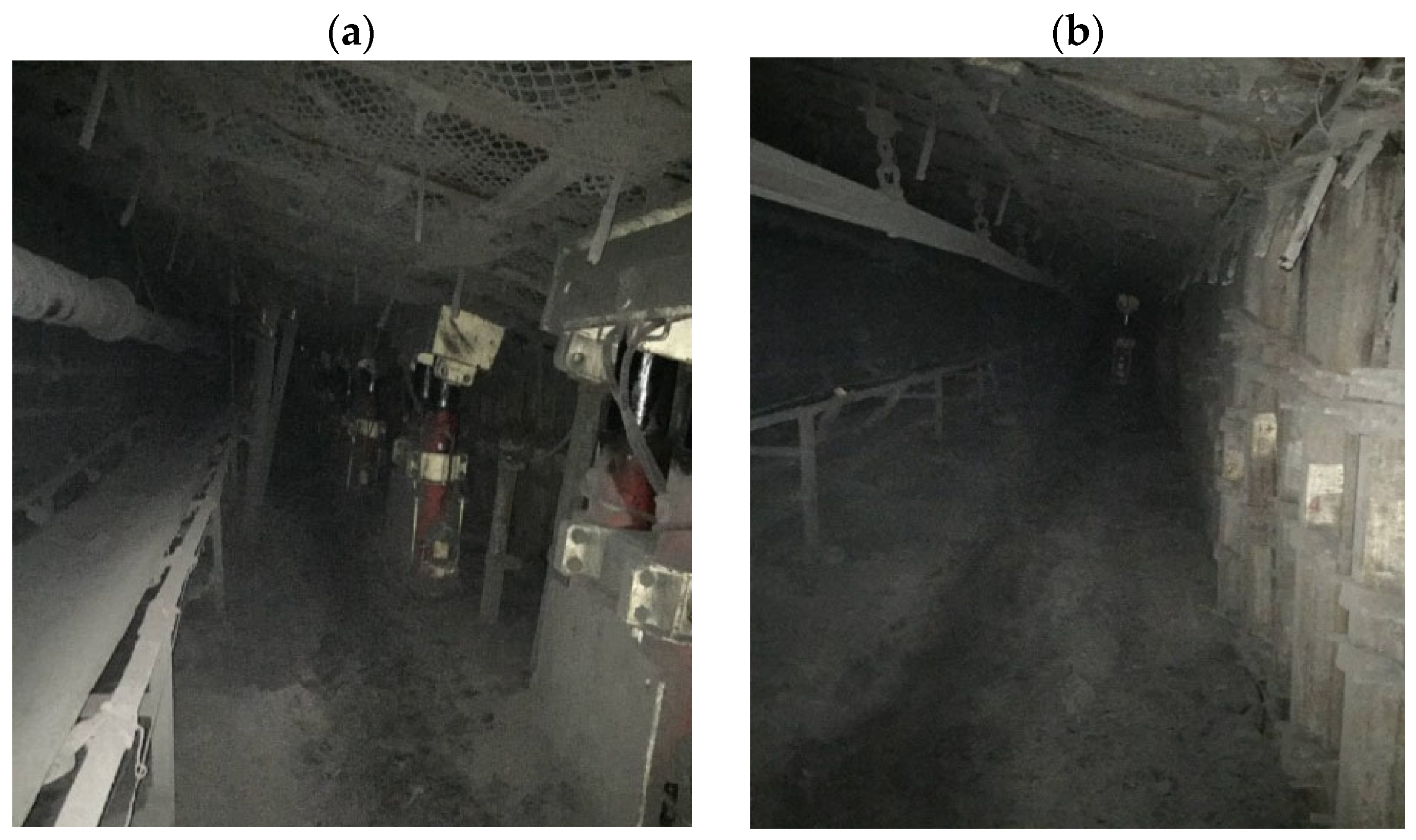
| Rock Formation | Formation Thickness m | Unit Weight kN/m3 | Bulk Modulus GPa | Shear Modulus GPa | Internal Friction Angle (°) | Cohesive Force MPa | Tensile Strength MPa |
|---|---|---|---|---|---|---|---|
| Mudstone | 7.00 | 24.00 | 2.88 | 1.53 | 26.00 | 1.17 | 1.30 |
| Fine sandstone | 14.00 | 26.00 | 10.35 | 7.74 | 36.00 | 3.15 | 4.20 |
| Mudstone | 5.00 | 24.00 | 2.88 | 1.53 | 26.00 | 1.17 | 1.30 |
| Sandy mudstone | 11.00 | 25.00 | 3.60 | 1.89 | 29.00 | 1.35 | 2.10 |
| Fine sandstone | 6.20 | 26.00 | 10.35 | 7.74 | 36.00 | 3.15 | 4.20 |
| Sandy mudstone | 3.00 | 25.00 | 3.60 | 1.89 | 29.00 | 1.35 | 2.10 |
| Coal | 3.30 | 14.00 | 1.35 | 0.63 | 23.00 | 0.72 | 0.14 |
| Mudstone | 2.00 | 24.00 | 2.88 | 1.53 | 26.00 | 1.17 | 1.30 |
| Middle sandstone | 20.00 | 26.00 | 9.38 | 6.54 | 34.00 | 3.13 | 3.40 |
| Structure | Shear Stiffness N/m | Normal Stiffness N/m | Poisson Ratio | Internal Friction Angle (°) |
|---|---|---|---|---|
| Surface | 1e8 | 2e6 | 0.25 | 15 |
Disclaimer/Publisher’s Note: The statements, opinions and data contained in all publications are solely those of the individual author(s) and contributor(s) and not of MDPI and/or the editor(s). MDPI and/or the editor(s) disclaim responsibility for any injury to people or property resulting from any ideas, methods, instructions or products referred to in the content. |
© 2024 by the authors. Licensee MDPI, Basel, Switzerland. This article is an open access article distributed under the terms and conditions of the Creative Commons Attribution (CC BY) license (https://creativecommons.org/licenses/by/4.0/).
Share and Cite
Liu, X.; Liang, Y.; Hua, X.; Qin, X. Research on Key Parameters for Relieving Pressure on Roofs of Deep Mine Cutting and Retaining Roadways. Appl. Sci. 2024, 14, 6785. https://doi.org/10.3390/app14156785
Liu X, Liang Y, Hua X, Qin X. Research on Key Parameters for Relieving Pressure on Roofs of Deep Mine Cutting and Retaining Roadways. Applied Sciences. 2024; 14(15):6785. https://doi.org/10.3390/app14156785
Chicago/Turabian StyleLiu, Xiao, Yuntao Liang, Xinzhu Hua, and Xinlin Qin. 2024. "Research on Key Parameters for Relieving Pressure on Roofs of Deep Mine Cutting and Retaining Roadways" Applied Sciences 14, no. 15: 6785. https://doi.org/10.3390/app14156785





